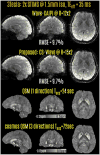Simultaneous Time Interleaved MultiSlice (STIMS) for Rapid Susceptibility Weighted acquisition
- PMID: 28435102
- PMCID: PMC5511575
- DOI: 10.1016/j.neuroimage.2017.04.036
Simultaneous Time Interleaved MultiSlice (STIMS) for Rapid Susceptibility Weighted acquisition
Abstract
T2* weighted 3D Gradient Echo (GRE) acquisition is the main sequence used for Susceptibility Weighted Imaging (SWI) and Quantitative Susceptibility Mapping (QSM). These applications require a long echo time (TE) to build up phase contrast, requiring a long repetition time (TR), and leading to excessively lengthy scans. The long TE acquisition creates a significant amount of unused time within each TR, which can be utilized for either multi-echo sampling or additional image encoding with the echo-shift technique. The latter leads to significant saving in acquisition time while retaining the desired phase and T2* contrast. In this work, we introduce the Simultaneous Time Interleaved MultiSlice (STIMS) echo-shift technique, which mitigates slab boundary artifacts by interleaving comb-shaped slice groups with Simultaneous MultiSlice (SMS) excitation. This enjoys the same SNR benefit of 3D signal averaging as previously introduced multi-slab version, where each slab group is sub-resolved with kz phase encoding. Further, we combine SMS echo-shift with Compressed Sensing (CS) Wave acceleration, which enhances Wave-CAIPI acquisition/reconstruction with random undersampling and sparsity prior. STIMS and CS-Wave combination thus yields up to 45-fold acceleration over conventional full encoding, allowing a 15sec full-brain acquisition with 1.5 mm isotropic resolution at long TE of 39 ms at 3T. In addition to utilizing empty sequence time due to long TE, STIMS is a general concept that could exploit gaps due to e.g. inversion modules in magnetization-prepared rapid gradient-echo (MPRAGE) and fluid attenuated inversion recovery (FLAIR) sequences.
Keywords: CS-Wave; Echo-Shift; QSM; SMS; STI; SWI; Wave-CAIPI.
Copyright © 2017 Elsevier Inc. All rights reserved.
Figures








Similar articles
-
Accelerated spin-echo functional MRI using multisection excitation by simultaneous spin-echo interleaving (MESSI) with complex-encoded generalized slice dithered enhanced resolution (cgSlider) simultaneous multislice echo-planar imaging.Magn Reson Med. 2020 Jul;84(1):206-220. doi: 10.1002/mrm.28108. Epub 2019 Dec 16. Magn Reson Med. 2020. PMID: 31840295 Free PMC article.
-
Compressed Sensing-Sensitivity Encoding (CS-SENSE) Accelerated Brain Imaging: Reduced Scan Time without Reduced Image Quality.AJNR Am J Neuroradiol. 2019 Jan;40(1):92-98. doi: 10.3174/ajnr.A5905. Epub 2018 Dec 6. AJNR Am J Neuroradiol. 2019. PMID: 30523142 Free PMC article.
-
GRAPPA reconstructed wave-CAIPI MP-RAGE at 7 Tesla.Magn Reson Med. 2018 Dec;80(6):2427-2438. doi: 10.1002/mrm.27215. Epub 2018 Apr 16. Magn Reson Med. 2018. PMID: 29663507
-
Magnetic resonance imaging of the subthalamic nucleus for deep brain stimulation.J Neurosurg. 2016 Jan;124(1):96-105. doi: 10.3171/2015.1.JNS142066. Epub 2015 Aug 21. J Neurosurg. 2016. PMID: 26295914 Review.
-
Simultaneous multislice (SMS) imaging techniques.Magn Reson Med. 2016 Jan;75(1):63-81. doi: 10.1002/mrm.25897. Epub 2015 Aug 26. Magn Reson Med. 2016. PMID: 26308571 Free PMC article. Review.
Cited by
-
Validation of Highly Accelerated Wave-CAIPI SWI Compared with Conventional SWI and T2*-Weighted Gradient Recalled-Echo for Routine Clinical Brain MRI at 3T.AJNR Am J Neuroradiol. 2019 Dec;40(12):2073-2080. doi: 10.3174/ajnr.A6295. Epub 2019 Nov 14. AJNR Am J Neuroradiol. 2019. PMID: 31727749 Free PMC article.
-
Penumbra Detection With Oxygen Extraction Fraction Using Magnetic Susceptibility in Patients With Acute Ischemic Stroke.Front Neurol. 2022 Feb 11;13:752450. doi: 10.3389/fneur.2022.752450. eCollection 2022. Front Neurol. 2022. PMID: 35222239 Free PMC article.
-
Improvement of Signal Inhomogeneity Induced by Radio-frequency Transmit-related Phase Error for Single-step Quantitative Susceptibility Mapping Reconstruction.Magn Reson Med Sci. 2019 Oct 15;18(4):276-285. doi: 10.2463/mrms.tn.2018-0066. Epub 2019 Feb 25. Magn Reson Med Sci. 2019. PMID: 30799332 Free PMC article.
-
Highly accelerated intracranial time-of-flight magnetic resonance angiography using wave-encoding.Magn Reson Med. 2023 Aug;90(2):432-443. doi: 10.1002/mrm.29647. Epub 2023 Apr 3. Magn Reson Med. 2023. PMID: 37010811 Free PMC article.
-
Accelerated spin-echo functional MRI using multisection excitation by simultaneous spin-echo interleaving (MESSI) with complex-encoded generalized slice dithered enhanced resolution (cgSlider) simultaneous multislice echo-planar imaging.Magn Reson Med. 2020 Jul;84(1):206-220. doi: 10.1002/mrm.28108. Epub 2019 Dec 16. Magn Reson Med. 2020. PMID: 31840295 Free PMC article.
References
-
- Bilgic B, Marques JP, Wald LL, Setsompop K. Block Coil Compression for Virtual Body Coil without Phase Singularities. Fourth International Workshop on MRI Phase Contrast & Quantitative Susceptibility Mapping 2016a
-
- Bilgic B, Polimeni JR, Wald LL, Setsompop K. Automated Tissue Phase and QSM Estimation from Multichannel Data. Proceedings of the 24th Annual Meeting ISMRM2. 2016b:2849.
-
- Bilgic B, Ye H, Wald LL, Setsompop K. Proceedings of the 24th Annual Meeting. ISMRM; 2016c. Optimized CS-Wave Imaging with Tailored Sampling and Efficient Reconstruction; p. 612.
Publication types
MeSH terms
Grants and funding
LinkOut - more resources
Full Text Sources
Other Literature Sources
Medical

